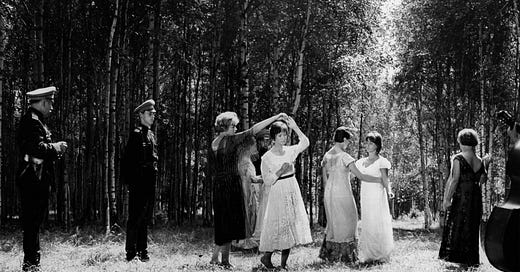Reeling Backward: The Red and the White (1967)
Hungarian master Miklós Jancsó's seminal film is both masterful and absurdist, using cutting-edge cinematic techniques to show the chaos and pointlessness of war.
It’s not hard to watch Miklós Jancsó’s seminal 1967 film, “The Red and the White,” and see the genetic material of more recent films like Sam Mendes’ “1917.”
Jancsó employed tracking shots, very long takes and an organic Neorealist feel to his filmmaking. We watch groups of soldiers running this way and that, tense encounters between officers and civilians, the group having the upper hand turned into the victims in the next moment.
The experience of watching this film is jangled and unnerving, with the sense anything could happen from one second to the the next because there’s no rhyme or reason to human capriciousness and cruelty.
It’s essentially a characterless film, set in 1919 during the Russian Revolution as Hungarian soldiers are caught in the fight between the Bolsheviks (Reds) and the anti-communist White Guards. Figures flit about in the background, come to the fore, then disappear and are replaced by others.
It’s a surging carnival of faces and death, sadism and fleeting glimpses of grace.
A fantastic new collection of Jancsó’s key filmography, including “The Red and the White” and six other films, is now out on Blu-ray and well worth a purchase. I’m planning to continue exploring it myself.
It was originally a joint Soviet-Hungarian project commissioned to celebrate the 50th anniversary of the October Revolution when communists seized power. But Jancsó went a very different way, portraying both the Reds and the Whites as capable of terrible acts of depravity. It was heavily re-edited for its USSR release.
The film is driven by the incredible black-and-white photography of Tamás Somló. The camera tracks back and forth across the battlefield near the Volga River, with nearly the entirety of the movie set outdoors. The imagery is haunting because it’s such a natural state without embellishment or pretense. Nothing is hidden.
It isn’t really possible to describe the plot, since it’s essentially a series of vignettes. Some Hungarian soldiers are captured while fighting for the Bolsheviks, and separated out from the Russians POWs and allowed to leave. They are later recaptured and some offer to join the Whites. Really, all they want to do is leave this senseless war and return home.
Meanwhile, the Russian prisoners are given 15 minutes to run away, but are trapped inside the town walls and hunted down mercilessly. A few overcome the White soldiers and fight back, including a puckish Mongol who steals an officer’s horse.
At one point the action shifts to a makeshift hospital treating wounded soldiers from both sides. The nurses are rounded up by a seemingly polite White officer (“if you please…”) and taken to a remote forest location. Our mind goes to terrible places: rape, torture, mass burial. Instead they are asked to waltz with each other accompanied by a military band, then let go.
Krystyna Mikołajewska plays one of the younger, pretty nurses singled out by the soldiers. She sympathizes with the Hungarians, exchanging a kiss with one of the commanders, and then strips down to bathe in the river to create a distraction while he escapes.
Later, she is forced by a White officer to identify which of the wounded soldiers are Russian and which are Hungarian, upon threat of her life. But minutes later the Reds recapture the hospital and she is executed for treason.
A lot of the worst violence takes place off camera, with Jancsó panning away before shots are fired, or cutting back just as the bodies fall. It’s as if to comment that the loss of human life has become so common and uneventful, it’s barely worth the witnessing.
There’s a whole lot of undressing in the movie. Whenever a soldier is captured, he is forced to remove his uniform, belt, boots, etc., sometimes even stripping all the way down to underwear or even nothing.
When an officer and his soldiers invade a small family farm, he makes the young woman strip nude for his own amusement, which is interrupted when the enemy suddenly appears and captures them, and the man who ordered the stripping is now forced to defenestrate himself before being summarily executed.
There’s nothing lascivious about the nudity in “The Red and the White,” which was probably still fairly novel in 1967. Again, the way it plays in the movie is that the human body is just another object that can be torn and perforated during the madness of war.
Why obscure that? Is it really more shocking to see a naked body, or one that’s been shredded by bullets and mortars?
I’ve read that some people don’t viscerally connect to “The Red and the White,” seeing it as a confusing panoply of people hurrying about, pushed and pulled this way and that. This even extends to not being entirely certain which faction of soldiers is currently in control of a particular area. Other than their uniforms, which are grimy or sometimes stripped away, it’s hard to tell the men apart.
That’s the point — does it really matter, when the savage outcome is much the same whoever’s currently in charge?
The fact the people we see largely remain nameless and there’s no set roster of central characters makes the film more emotionally immediate, not less. It underscores how this could be any of us, pulling the trigger or in front of the barrel.
It’s a cynical, but sadly realistic portrait of humanity, an endless cycle of victims and victimizers exchanging places in a grim dance without ending.





